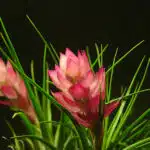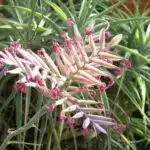Tillandsia cyanea is an intriguing epiphytic air plant from South America, whose captivating beauty and diverse growing habit have enchanted gardeners since the days of Ancient Rome. With such a long and storied history, it’s no wonder Tillandsia cyanea has become one of the most sought-after specimens for those looking to add a touch of exotic elegance to their homes or gardens. But before you set out on your Tillandsia cyanea journey, it’s important that you understand the ins-and-outs of caring for this unique species.
In this article, we will explore the basics of Tillandsia cyanea care, including its ideal environment, feeding habits, and how to propagate new plants. Whether you’re a novice gardener or an experienced botanist looking to dive into the fascinating world of air plants, this guide will provide you with all the information you need to cultivate a thriving T. cyanea population!
From understanding its light requirements to replicating its native habitat in your own home or garden, this plant care & growing guide will provide all the tips and tricks necessary for successfully cultivating Tillandsia cyanea – so let’s get started!
Identifying Tillandsia Cyanea
Tillandsia cyanea is a delightful species of flowering plants, belonging to the bromeliad family. It’s a fast-growing evergreen perennial, with beautiful silvery-green leaves and bright pink flowers. To the keen eye, identifying this species is a breeze, as it stands out in any garden landscape.
Like most bromeliads, Tillandsia cyanea prefers bright indirect light and humid environments to thrive. As it’s native to Central America, it loves warm temperatures year round and needs regular misting or soaking to keep its roots hydrated. The soil should be light and well-draining, so avoid overwatering as this can cause root rot.
To ensure your Tillandsia cyanea stays healthy and happy, fertilize every month during the growing season with an organic fertilizer that’s low in nitrogen. With adequate care, this plant will reward you with colorful blooms throughout summertime!
Where To Find Tillandsia Cyanea
Tillandsia cyanea is a unique species of air plant native to Central and South America. They are some of the most diverse air plants in terms of color, with vibrant greens, purple-blues, and deep oranges. It’s no wonder that this species is becoming increasingly popular among plant enthusiasts! To find these plants, you can look for them at local nurseries or online retailers that specialize in air plants.
For those looking to add a bit of nature to their home décor, Tillandsia cyanea may be the perfect choice. Not only are they beautiful, but they require minimal care and thrive in natural light. With proper knowledge of its growing requirements, you can quickly create an eye-catching display that will last for years to come.
Finding Tillandsia cyanea isn’t difficult as it is widely available from both retail outlets and online stores. However, it’s important to take your time when selecting a specimen as quality does vary between sources. Make sure that the plant has healthy roots and leaves before making your purchase – this will ensure that it remains healthy for months or even years after you’ve brought it home! Now that we have discussed where to find Tillandsia cyanea, let’s move on to discussing its growing requirements.
Growing Requirements For Tillandsia Cyanea
The proper growing requirements for Tillandsia cyanea are essential for a successful and healthy plant. This tropical air plant species is native to Central America, but it can be grown in many parts of the world. Here, we’ll discuss how to provide ideal growing conditions so you can enjoy these vibrant plants in all their glory.
Tillandsia cyanea needs bright, indirect light and temperatures between 50-90°F (10-32°C). Humidity levels should remain around 50%, with regular misting recommended to keep the foliage hydrated. These plants are epiphytic, meaning they do not require soil and instead draw moisture and nutrients from the air and surrounding environment. As such, there’s no need to fertilize them unless you’re looking to enhance growth and flower production.
It’s also important to ensure that Tillandsia cyanea gets sufficient airflow as this helps keep the leaves dry and prevent fungal diseases from developing. To maximize this effect, place your plants at least 6 inches (15 cm) apart from one another or use a fan nearby on a low setting. With these tips in mind, you’re ready to create an environment that will help your Tillandsia cyanea thrive and show off its beautiful foliage! With the right care, these hardy plants make wonderful additions to any home or garden – now it’s time to decide which vessel will best showcase them.
Choosing A Containing Vessel For Tillandsia Cyanea
Setting up the perfect home for your Tillandsia Cyanea is like finding the ultimate paradise for a king! Crafting the perfect container can be an absolute thrill and a joy to behold. With the right vessel, you will have a verdant garden of lush green foliage that exudes life and beauty.
When choosing a vessel for your Tillandsia Cyanea, there are some important considerations. Firstly, make sure it has plenty of room for growth – too little room, and your plant may become stunted. Secondly, make sure it has ample drainage holes; otherwise, your plant could suffer from root rot. Lastly, remember that different containers serve different purposes: hanging baskets can add an eye-catching design element to any space while terrariums keep moisture levels in check so you don’t need to water as often.
No matter what type of container you choose, make sure it fits with your decor style and provides enough room for growth. With that in mind, let’s get ready to prepare the growing medium for our Tillandsia Cyanea!
Preparing The Growing Medium For Tillandsia Cyanea
Would you like to learn how to prepare the growing medium for Tillandsia Cyanea, an epiphytic plant? As a botany and gardening specialist, I’ll provide the essential information you need!
First, it’s important to understand the environment of Tillandsia Cyanea before considering what type of growing medium is suitable. This plant requires bright indirect light, high humidity levels and good air circulation. To maintain these conditions, it’s best to use a porous material which will allow water to pass through easily. The likes of sphagnum moss or coconut husk fibers are great for this purpose.
Once you’ve selected your growing medium, soak it in water and then wring out the excess moisture. This will ensure that the roots can absorb enough water without drowning them. Additionally, you may want to add some fertilizer or other nutrients into the mix. This will help boost growth and keep your Tillandsia Cyanea healthy over time.
Now that you have the right growing medium and ingredients prepared, you’re ready to start planting! Make sure you position your Tillandsia Cyanea in its container correctly so that it gets plenty of light and adequate airflow. Also consider adding a few drops of water every day or so during dry periods; this will help keep your plant hydrated and happy!
Planting Tillandsia Cyanea
Planting Tillandsia Cyanea is an important step in the successful cultivation of this beautiful and versatile air plant. To get started, there are a few key points to keep in mind:
• Get a container that has ample drainage holes or create one using perforated plastic or terra cotta pots. • The growing medium should be light and porous, such as sphagnum moss, coarse sand, or vermiculite. • Ensure that the roots are completely covered with the medium. • When planting multiple plants together, make sure to leave enough space between them. • Water lightly after planting and then wait until the medium is dry before watering again.
Preparing the correct growing medium for Tillandsia Cyanea is essential for its successful cultivation. By following these simple steps when planting, you can ensure that your air plant will have all the necessary elements to thrive in its environment. Once planted, it’s important to monitor the moisture levels of your Tillandsia Cyanea and adjust your watering regimen accordingly. This will ensure that it gets adequate hydration without becoming waterlogged and potentially suffering from root rot. In order to provide optimal care for your Tillandsia Cyanea, we must now turn our attention to understanding its specific watering needs.
Tillandsia Cyanea Watering Needs
It’s true that the care for tillandsia cyanea may seem intimidating, but with the correct knowledge and dedication, you can have a thriving and beautiful plant. When it comes to watering needs of this species, there are certain considerations to take into account. As specialists in botany and gardening, let us guide you through the process of understanding what your plant needs.
Firstly, you should know that tillandsia cyanea is an epiphytic species and requires little water compared to other houseplants. It is best to water the plant every two weeks using either rainwater or distilled water. This should be done by submerging the plant in a bowl of water for 15 minutes and then allowing it to dry completely before putting it back in its spot. Make sure not to leave your plant in standing water as this can lead to root rot.
Additionally, if your tillandsia cyanea is situated in an area exposed to direct sunlight or with high humidity levels, misting it twice a week will help keep it hydrated without causing any damage. Use a spray bottle filled with rainwater or distilled water for best results. The most important thing when watering this species is not to overdo it – too much moisture could cause rot and attract pests like mealybugs and fungus gnats.
By following these guidelines, you can provide your tillandsia cyanea with the perfect balance of moisture while ensuring its healthy growth. With proper maintenance and care, you can enjoy its beauty for many years! Now let us move onto discussing fertilization requirements for this stunning epiphyte!
Tillandsia Cyanea Fertilization Requirements
It is generally accepted that fertilization can be beneficial for growing tillandsia cyanea, but is it necessary? In order to find out we must look at the plant’s natural growing environment. Tillandsia cyanea naturally grows in areas of high humidity and abundant rainfall where the soil is often nutrient deficient, so clearly the plant has adapted to survive in such conditions. Therefore, proper fertilization of tillandsia cyanea may prove beneficial for optimal growth, but it isn’t absolutely necessary.
When deciding on what type of fertilizer to use, there are a few things to consider. For example, liquid fertilizer can be applied directly to the soil or foliage but will need to be applied more frequently than slow-release fertilizers which release their nutrients over a longer period of time. Additionally, organic fertilizers are usually recommended as they are less likely to burn the plant and provide a more balanced nutrient supply which mimics natural conditions more closely.
Ultimately, while adding fertilizer can increase growth rate and size of tillandsia cyanea plants, it’s important not to overdo it and potentially damage them instead. A general rule of thumb when applying any type of fertilizer is to use half the recommended amount and monitor your plants’ response before increasing application rates as needed. This way you can ensure healthy growth without risking any potential harm.
Pruning Tillandsia Cyanea
Pruning Tillandsia Cyanea is a necessary and important step in the care of these plants. Regular pruning will keep them healthy by allowing for better air circulation, giving way to new growth, and making them look more attractive. To properly prune your Tillandsia Cyanea, here are three steps you should follow:
First, assess the overall shape of your plant. Are there any stems that are too long? Are the leaves clustered together in one place? If so, it’s time to take action. Using sharp shears or scissors, trim off any stems that are longer than necessary for the desired shape of your plant. Cut back any dead or dying leaves as well.
Next, focus on thinning out overcrowded areas of the plant. This will help promote better air circulation which can increase their health and vitality. With careful snips, remove some of the excess foliage until you achieve a balance between light exposure and air flow.
Finally, clean up any debris from around your Tillandsia Cyanea to ensure that it looks neat and tidy. By doing this regularly, you can give your plant a much-needed boost of energy to help it thrive in its environment!
Propagation Of Tillandsia Cyanea
Ah, propagation of Tillandsia Cyanea. It’s the bane of many a botanist and gardener’s existence. After all, what is more annoying than having to propagate one of the most beautiful plants in the world? But alas, here we are! The good news is that propagating this enchanting little plant is not as difficult as you might think.
Firstly, you’ll need to choose a method of propagation, such as division or cuttings. To divide your Tillandsia Cyanea, identify a mature root clump and carefully break it apart with your hands into smaller sections. Each section should have at least two leaves and a few roots. Plant each section in its own pot filled with well-draining soil and ensure that it has adequate light and water.
For cuttings, use sharp scissors to snip off the top two inches of the plant. Place the cutting in clean water or moist sphagnum moss until new roots have formed (about three weeks). Once roots have developed, transfer the cutting to its own pot filled with well-drained soil mix and provide adequate light and water.
No matter which method you choose, be sure to monitor your Tillandsia Cyanea for common pests or diseases before transferring them into their permanent home. Doing so will help ensure that your beautiful plant remains healthy for years to come!
Common Pests And Diseases Of Tillandsia Cyanea
Tillandsia cyanea is a beautiful airplant with colorful, bright foliage. However, it is also susceptible to common pests and diseases that can be damaging if not addressed in time. Take, for example, the case of John who was growing this plant in his outdoor garden; he noticed some browning and black spots on the leaves and the plant was wilting. Upon inspection, he found that his Tillandsia cyanea had been infested with a fungus called Alternaria alternata which caused leaf spot disease.
In order to prevent pests and diseases from attacking Tillandsia cyanea, regular monitoring of the plants health is essential. The most common pests that attack this species are mealybugs and aphids which can be identified by their sticky secretions or white cotton-like masses on the plant’s leaves. In addition to these insects, scale insects can also cause damage to Tillandsia cyanea if left unchecked. It’s important to inspect the plants regularly for signs of infection and take necessary action as soon as possible if any are spotted.
Fungal infections such as powdery mildew and leaf spot disease can also affect this airplant and should be treated using specific fungicides available at gardening stores. Fungicides containing copper or sulfur are effective in controlling these fungal diseases but should only be used as directed on the product label. Furthermore, ensuring adequate airflow around your Tillandsia cyanea will help reduce chances of fungal growth on the plant’s leaves since fungi thrive in moist environments with poor air circulation. Following these steps will help you keep your Tillandsia cyanea healthy and free from common pests and diseases.
Troubleshooting Tips For Tillandsia Cyanea
“Necessity is the mother of invention,” so troubleshooting any issue that arises with Tillandsia Cyanea is essential. Here are four tips to get you started:
- Check the environment – Too much direct sunlight, too little water, or improper air circulation can all be contributing factors to problems with your Tillandsia Cyanea.
- Monitor fertilizer usage – Overfertilizing can cause foliage burn and discoloration.
- Inspect for pests – Mealybugs, scales, thrips, and spider mites are some of the common pests that could affect your plant’s health.
- Check for diseases – Diseases like bacterial leaf spot and root rot can cause serious damage if left untreated.
As a botanist and gardening specialist, I recommend you pay close attention to the environment surrounding your Tillandsia Cyanea and take preventive measures against pests and diseases. Be sure to provide adequate drainage for your plant as well as enough light and air circulation. If any problems arise, it’s important to treat them immediately before they become more severe.
Taking these precautions will put you in a better position to meet the needs of your Tillandsia Cyanea so it can thrive in its new home. With a little bit of effort, your plant will reward you with beautiful blooms that will last for many years to come! Now let’s move on to discuss different types of Tillandsia Cyanea…
Types Of Tillandsia Cyanea
Tillandsia cyanea is like a beautiful flower in the garden of life, blooming with endless possibilities. It’s easy to be captivated by its striking beauty and unique characteristics, but let’s not forget about the different types of this amazing plant. With its wide variety of shapes, sizes, and colors, Tillandsia cyanea can bring a lot of life to any space.
The most common type of Tillandsia cyanea found in gardens is the upright form. This form has a strong stem that can reach up to two feet tall and produces large clusters of delicate pink or blue blossoms. Another type is the semi-trailing form, which grows outwards from its main stem and produces smaller flowers in shades of purple and yellow. Lastly, there are several varieties with long slender leaves and small vivid flowers that make great hanging plants or ground coverings.
No matter what type you choose for your garden or landscape design, Tillandsia cyanea needs plenty of light and humidity in order to thrive. Make sure to water it regularly and provide ample airflow around the plant for best results. TIP: If you’re looking for more color and texture in your outdoor space, consider planting multiple types of Tillandsia cyanea together! This will create a beautiful patchwork of color that will add interest to your landscape all year round.
Uses For Tillandsia Cyanea
Tillandsia cyanea is a species of epiphytic bromeliad native to the rainforests of Central and South America. It is an attractive plant with long, narrow green leaves and bright pink or purple flowers that make it popular for use in home gardens. But did you know that Tillandsia cyanea can be used in other ways as well?
Tillandsia cyanea has many practical applications, from adding beauty to your garden to creating unique decorations inside your home. As an air-plant, it doesn’t need soil and can be attached to any surface using adhesive or wire. This makes it perfect for hanging baskets, wall planters, terrariums, and more. It’s even possible to create living sculptures out of Tillandsia cyanea by attaching several plants together with wire or glue.
The foliage of Tillandsia cyanea is also useful for crafting projects such as dried flower arrangements and wreaths. Just cut off a few stems and hang them upside down in a dark location until they’re dry enough to use. The leaves can also be used for making homemade natural dyes for fabric or paper projects. So the next time you’re looking for something special to add to your craft supplies, consider Tillandsia cyanea!
These are just a few of the many uses for this versatile plant. With its eye-catching colors and easy maintenance requirements, Tillandsia cyanea is a great addition to any home or garden – no matter how much space you have available!
Tips For Growing Tillandsia Cyanea Successfully
Growing a successful Tillandsia cyanea can be a challenge, but it doesn’t have to be. By following these tips, you can have beautiful indoor plants that will last for years. So, let’s explore how to make sure your Tillandsia cyanea thrives:
First and foremost, ensure that you provide the plant with plenty of indirect sunlight during the day. This will help the plant photosynthesize and grow healthy leaves. If you don’t have access to natural light, try using a fluorescent or LED bulb for an artificial source of light.
Additionally, it is important to keep your Tillandsia cyanea moist at all times. You can do this by misting it regularly with distilled water or giving it a weekly soak in water for about 15 minutes. Make sure not to over-water your plant as this can lead to root rot and other health issues. Here are some more tips on how to make sure your Tillandsia cyanea is always healthy:
• Mist the leaves daily or every few days • Place the plant in an area with good air circulation • Fertilize once a month with a specially formulated fertilizer • Water lightly when soil begins to dry out • Trim any dead leaves regularly
By taking care of your Tillandsia cyanea properly and making sure they get enough light and moisture, you’ll be able to enjoy their beauty for many years! As long as you follow these simple tips, you can look forward to growing healthy plants that thrive indoors!
Frequently Asked Questions
How Often Should I Mist Tillandsia Cyanea?
If you’ve been wondering how best to care for your Tillandsia cyanea, you’re in luck. As the premier specialist in botany and gardening, I’m here to provide you with all the information you need to keep your plant healthy and happy. Now, let’s get down to brass tacks… How often should you be misting Tillandsia cyanea? Well, here’s the thing: it depends.
You see, much like humans, plants have different needs depending on their environment. If you live in an area with high humidity levels, then you’ll only need to mist your Tillandsia once a week or so. On the other hand, if your climate is on the drier side then misting twice a week should do the trick. The key is to keep an eye on your plant and adjust accordingly.
It’s also important to note that certain species of Tillandsia require more frequent misting than others – particularly those from tropical climates. So if you want to make sure your cyanea stays vibrant and blooms its best flowers, it’s a good idea to give it an extra spritz or two whenever possible!
Now that we’ve cleared up the mystery of misting frequency for Tillandsia cyanea (phew!), all that’s left is for you to get out there and take proper care of your beautiful plant! With just a bit of effort and patience on your part, it will reward you with years of cheerful greenery – perfect for brightening up any home or garden!
How Much Sun Does Tillandsia Cyanea Need?
Growing Tillandsia cyanea is a rewarding experience. With the right amount of sunlight and misting, you can enjoy these showy plants all year round. But just how much sun does Tillandsia cyanea need? Let’s explore this question together.
As a specialist in botany and gardening, I can assure you that Tillandsia cyanea are quite adaptable when it comes to light requirements. They do best in bright, indirect light and thrive in temperatures between 65-75°F (18-24°C). If grown indoors, put your Tillandsia near an east-facing window to ensure they get enough bright light without overheating. For outdoor growing, place them in a location with morning sun but afternoon shade to protect them from direct exposure to intense sunshine.
When caring for your Tillandsia cyanea, keep in mind that too much direct sunlight can cause burning of the foliage and too little will cause them to become weak and leggy due to lack of energy production for growth. By providing the proper lighting environment for your plant, you can ensure its long-term health and beauty as well as encourage more blooms throughout the year!
Providing adequate care requires understanding the specific needs of each type of plant. Knowing how much sun your Tillandsia cyanea needs is an important part of successful gardening – one that will reward you with years of enjoyment from these stunning plants!
What Type Of Potting Soil Is Best For Tillandsia Cyanea?
Tillandsia cyanea is a gorgeous, low-maintenance houseplant that’s perfect for those who are just starting out in gardening. But to keep it in tiptop condition, it’s important to get the potting soil right. So what type of potting soil is best for this plant?
The key is to strike a balance between providing good drainage and supplying the nutrients that the plant needs. A lightweight, organic-based potting mix works best – one with lots of peat moss, perlite, and/or coarse sand will help ensure optimal drainage while also allowing the roots to absorb moisture and nutrients from the soil. Additionally, you may want to add a slow-release fertilizer such as fish emulsion or compost tea to provide even more nourishment for your plant.
It’s also important that you use a container with adequate drainage holes so excess water can escape quickly – if too much water stays trapped in the soil, this can cause root rot or fungal infections which can quickly kill your plant. Of course, you can always make your own custom potting mix if that’s more convenient for you – just make sure it provides plenty of aeration and enough nutrition for your Tillandsia cyanea!
Is Tillandsia Cyanea Toxic To Pets?
Are you worried that the beautiful Tillandsia cyanea in your home is potentially toxic to your furry friends? Get ready for a shock – this gorgeous species of flower is, in fact, highly hazardous. Let me tell you why!
The Tillandsia cyanea contains several dangerous compounds like benzene and formaldehyde. Not only are they toxic when ingested, but they can also be very irritating to the skin and eyes. Here’s a list of 3 things you should look out for:
- Poisonous foliage: The leaves contain substances that can cause severe rashes and other skin irritations.
- Respiratory irritation: The presence of benzene can lead to coughing and other respiratory problems when inhaled.
- Toxic ingestion: If eaten, the plant may cause vomiting, dizziness, headaches, or even death in some cases if not treated quickly enough.
As a specialist in botany and gardening, I urge all pet owners who own a Tillandsia cyanea to take extra precautions with their plants – keep them away from children and animals as much as possible! It’s always best to err on the side of caution when it comes to any potentially dangerous plants in your home – especially ones with such beautiful blooms as the Tillandsia cyanea!
How Do I Know When To Repot My Tillandsia Cyanea?
Repotting a Tillandsia cyanea is an important step in keeping your plant healthy and vibrant. Symbolically, it’s like cleaning out the old and making room for new growth. With the right care, this beautiful epiphyte can be a stunning addition to any home or garden. Here’s what you need to know about when to repot your Tillandsia cyanea:
Look for signs of root development. A mature Tillandsia cyanea will have roots that are visible around the base of the plant. When these roots become too densely packed, it’s time to repot.
Monitor its watering needs. If you find yourself needing to water more frequently than usual, then it may be time to give your plant a bit more space.
Check for signs of stress or wilting leaves. A Tillandsia cyanea that is becoming root-bound will often show signs of stress or wilting leaves before other symptoms appear. Repotting at this point can help revive your plant and keep it thriving.
These are all good indicators that it’s time for a repotting session for your Tillandsia cyanea! As a specialist in botany and gardening, I recommend using a pot with drainage holes and selecting the appropriate soil mix for best results. It’s also important to make sure you use gloves when handling this delicate plant as its leaves can easily be damaged if handled roughly. By following these simple steps, you can ensure that your Tillandsia cyanea stays healthy and continues to bring beauty into your life!
Conclusion
Tillandsia cyanea is an epiphytic species of bromeliad native to Central and South America. This unique plant makes a wonderful addition to any garden, balcony, or terrarium. With proper care, Tillandsia cyanea will thrive in almost any environment, as long as it receives moderate light and is regularly misted.
When caring for this species of bromeliad, it is important to use the right type of potting soil and provide adequate sunlight. Additionally, pet owners should be aware that some species of Tillandsia are toxic to animals. As Tillandsia cyanea grows over time, you may need to repot it into a larger container.
Overall, with the right amount of light and regular misting, Tillandsia cyanea can make a stunning addition to your garden or home decor. Taking the time to properly care for your plants will ensure they remain healthy and vibrant for years to come. With just a bit of effort and knowledge about its specific needs, you can enjoy this beautiful bromeliad for many years!





























